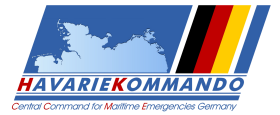History
By law the German states Lower Saxony, Hanseatic City of Bremen, Hanseatic City of Hamburg, Schleswig-Holstein and Mecklenburg Vorpommern are responsible for maritime emergency response in their coastal waters. Federal agencies such as the Federal Coast Guard are responsible for certain tasks. The large number of organizations and authorities led to a great need for coordination. The process of German maritime rescue and relief operations has often been criticized as dangerously bureaucratic, too slow and uncoordinated. On October 25, 1998, the Cargo ship M/V Pallas, cargo of lumber caught fire while traveling the North Sea off the west coast of Jutland. Several attempts to get the ship under tow were unsuccessful, and it ran aground four days later off the German island of Amrum, in the Schleswig-Holstein Wadden Sea National Park. 250 tons of fuel oil were lost overboard, causing the biggest oil spill in German history, killing approximately 16.000 sea birds, predominantly common eiders. The case led to political discontent over a lack of coordinated emergency tow capabilities on the German coast, and contributed to the creation CCME. [1]
The Federal Coastal States and the Federal Government authorities founded CCME. On January 1, 2003, the Central Command for Maritime Emergencies (CCME) (in German: Havariekommando) commenced operations. It was established to set up and carry out a mutual maritime emergency management in the North Sea and in the Baltic Sea. It is based in Cuxhaven (Northwest Germany) and is headed by a federal official. [2]
This page is based on this
Wikipedia article Text is available under the
CC BY-SA 4.0 license; additional terms may apply.
Images, videos and audio are available under their respective licenses.



